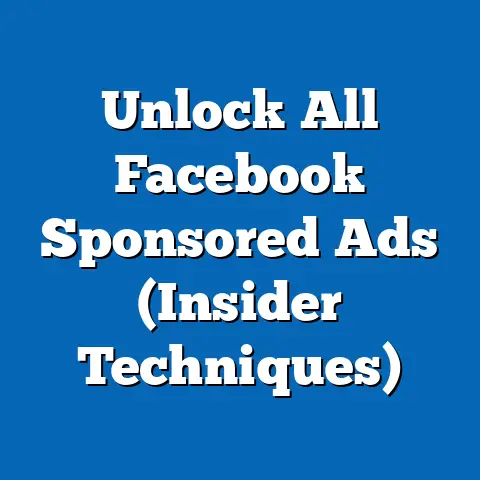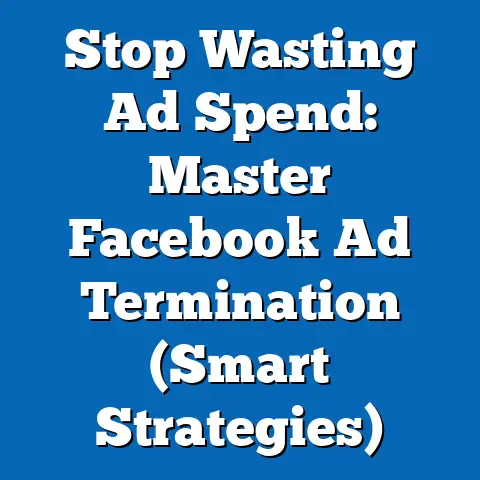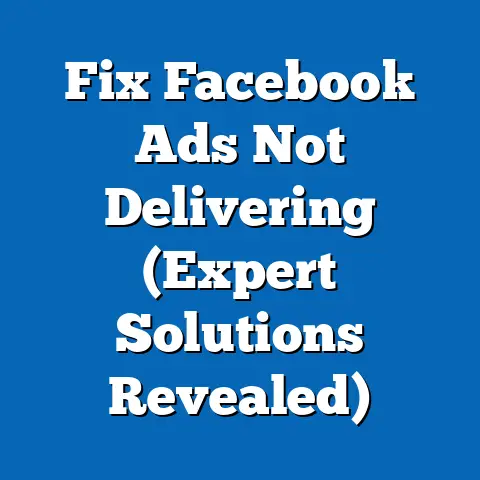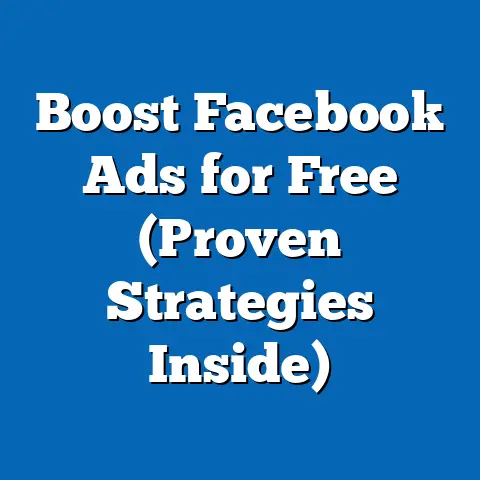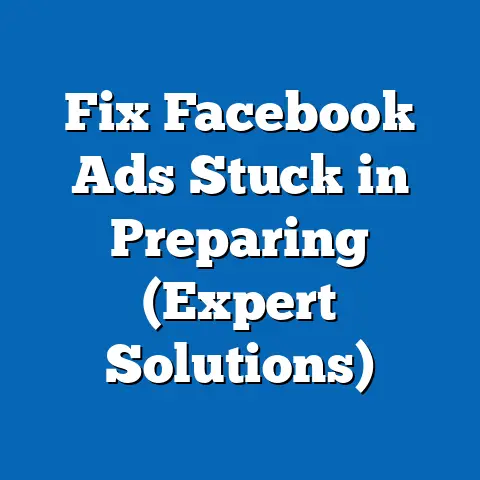Struggling to See Facebook Ad? (Pro Tips Inside)
I remember when I first started diving into the world of digital advertising, Facebook Ads felt like unlocking a secret door to a massive audience. The promise of connecting with specific demographics, interests, and even behaviors seemed almost too good to be true. And in many ways, it was a game-changer. But what I quickly learned is that simply creating an ad and throwing money at it doesn’t guarantee success. In fact, many advertisers, just like I was back then, struggle to see the desired results, feeling like their ads are lost in the vast sea of content.
Facebook has undeniably transformed marketing for businesses of all sizes. Its targeted advertising capabilities allow you to reach specific demographics and interests with remarkable precision. We’ve seen a significant shift in consumer behavior, and businesses are constantly adapting to keep up. However, the reality is that while Facebook Ads can be an incredibly powerful tool, many advertisers face challenges in achieving the visibility and performance they expect.
That’s why I’m writing this guide – to share some pro tips that I’ve learned over the years that can help you overcome these challenges and enhance your Facebook ad performance. We’ll delve into the intricacies of the Facebook Ads ecosystem, explore common hurdles, and, most importantly, provide actionable strategies to boost your ad visibility and drive meaningful results.
Understanding the Facebook Ads Ecosystem
Think of the Facebook Ads ecosystem as a complex, yet fascinating, machine. To truly master it, you need to understand its inner workings. At its core, a Facebook Ads campaign is structured in a hierarchical manner:
- Campaign: This is the overarching objective of your advertising efforts. Are you looking to drive traffic to your website, generate leads, increase brand awareness, or boost sales? Your campaign objective sets the stage for your entire advertising strategy.
- Ad Sets: Within each campaign, you have ad sets. These are where you define your target audience, budget, placement (where your ads will appear), and schedule. Think of ad sets as the “who,” “where,” and “when” of your advertising.
- Ads: Finally, within each ad set, you have individual ads. These are the actual visuals and copy that your target audience will see. This is where you get creative and craft compelling messages that resonate with your intended audience.
Audience Targeting is Key: A crucial aspect of the Facebook Ads ecosystem is its sophisticated audience targeting capabilities. Facebook leverages vast amounts of user data – demographics, interests, behaviors, connections – to allow you to reach incredibly specific segments of the population. For example, you can target women aged 25-35 who are interested in yoga and live in a specific city. The possibilities are virtually endless!
The All-Important Ads Manager: Everything is managed through the Facebook Ads Manager, a central hub for creating, managing, and analyzing your campaigns. Within the Ads Manager, you’ll find a wealth of data and metrics that provide insights into your ad performance. Key metrics to watch include:
- Impressions: The number of times your ad was displayed.
- Reach: The number of unique people who saw your ad.
- Click-Through Rate (CTR): The percentage of people who saw your ad and clicked on it.
- Cost Per Click (CPC): The average cost you pay each time someone clicks on your ad.
- Conversions: The number of desired actions taken as a result of your ad (e.g., purchases, sign-ups, form submissions).
- Return on Ad Spend (ROAS): The revenue generated for every dollar spent on advertising.
Understanding this ecosystem is absolutely crucial for any advertiser looking to succeed on Facebook. Without a solid grasp of how the platform works, you’ll be essentially flying blind, making it difficult to optimize your campaigns and achieve your desired results.
Takeaway: Familiarize yourself with the structure of Facebook Ads campaigns and the role of the Ads Manager. Understanding how targeting works and the key metrics to monitor is fundamental to success.
Common Challenges Advertisers Face
Even with a solid understanding of the Facebook Ads ecosystem, many advertisers still encounter challenges along the way. Let’s explore some of the most common hurdles:
- Low Visibility: This is perhaps the most frustrating challenge. You’ve created your ad, set your budget, and launched your campaign, but it feels like no one is seeing it. This can be due to a number of factors, including a poorly defined target audience, low bidding, or unoptimized ad creative.
- Poor Click-Through Rates (CTR): Your ad is being seen, but people aren’t clicking on it. This suggests that your ad copy or visuals aren’t compelling enough to capture attention and drive engagement.
- Ineffective Targeting: You’re reaching the wrong people. Your ad might be relevant to your product or service, but it’s not resonating with the audience you’re targeting. This can lead to wasted ad spend and poor conversion rates.
- Ad Fatigue: Your audience is getting tired of seeing the same ad over and over again. This can lead to a decline in CTR and overall performance.
- Algorithm Changes: Facebook’s algorithm is constantly evolving, and these changes can significantly impact ad performance. What worked yesterday might not work today.
- Increased Competition: The Facebook Ads landscape is becoming increasingly competitive, with more and more businesses vying for the same audience’s attention. This can drive up ad costs and make it more challenging to stand out from the crowd.
Real-World Example: I once worked with a local bakery that was struggling to generate sales through Facebook Ads. They were targeting a broad audience with generic ads featuring their products. After analyzing their campaign, I realized that they were suffering from ineffective targeting. We refined their audience to focus on people who had previously visited their website or engaged with their social media content. We also created more visually appealing ads that highlighted specific promotions and seasonal offerings. As a result, their CTR increased significantly, and they saw a noticeable boost in sales.
Takeaway: Recognize that challenges are common in Facebook advertising. Understanding the potential pitfalls – low visibility, poor CTR, ineffective targeting, ad fatigue, algorithm changes, and increased competition – is the first step in overcoming them.
Pro Tips to Enhance Facebook Ad Visibility and Performance
Now for the good stuff! Let’s dive into some actionable pro tips that can help you enhance your Facebook ad visibility and performance:
Tip 1: Optimize Ad Creative
Your ad creative – the visuals and copy that make up your ad – is the first thing people will see. It’s your opportunity to grab their attention and entice them to learn more. Therefore, optimizing your ad creative is absolutely essential.
- Eye-Catching Visuals: Use high-quality images or videos that are visually appealing and relevant to your target audience. Consider using bright colors, interesting compositions, and images that evoke emotion.
- Compelling Copy: Your ad copy should be concise, engaging, and clearly communicate the value proposition of your product or service. Highlight the benefits, not just the features.
- Clear Call-to-Action (CTA): Tell people what you want them to do. Use strong action verbs like “Shop Now,” “Learn More,” “Sign Up,” or “Get Started.” Make your CTA button prominent and easy to click.
A/B Testing: Don’t just guess what works best. Use A/B testing to experiment with different ad creatives and see which ones perform best. Test different headlines, images, CTAs, and body copy to identify the winning combinations.
Tools & Techniques: There are numerous tools and techniques you can use to create engaging ads. Canva is a great option for creating visually appealing graphics, while Grammarly can help you refine your ad copy.
Example: Instead of using a generic photo of a product, try using a lifestyle image that shows someone using and enjoying your product. Instead of saying “We sell shoes,” try saying “Step into Comfort and Style with Our New Collection.”
Takeaway: Invest time and effort in creating high-quality, engaging ad creative. Experiment with different visuals and copy, and always include a clear call to action.
Tip 2: Refine Your Target Audience
Reaching the right people is just as important as having great ad creative. If you’re targeting the wrong audience, your ads will be wasted on people who are not interested in your product or service.
- Facebook Audience Insights: Use Facebook’s Audience Insights tool to gain a deeper understanding of your target audience. This tool provides valuable data on demographics, interests, behaviors, and connections.
- Custom Audiences: Create custom audiences based on your existing customer data, website traffic, or app activity. This allows you to target people who have already shown an interest in your brand.
- Lookalike Audiences: Expand your reach by creating lookalike audiences. These are audiences that share similar characteristics to your existing customers or website visitors. Facebook uses its data to identify people who are likely to be interested in your product or service.
Strategies for Expansion: Don’t be afraid to experiment with different targeting options. Try layering different interests or behaviors to see which combinations perform best.
Example: If you’re selling eco-friendly products, you could target people who are interested in sustainability, organic living, or environmentalism. You could also create a custom audience based on people who have visited your website or signed up for your email list.
Takeaway: Take the time to define and refine your target audience. Use Facebook’s Audience Insights tool to gain valuable data, and create custom and lookalike audiences to expand your reach.
Tip 3: Utilize Retargeting Strategies
Retargeting is a powerful strategy that allows you to re-engage potential customers who have previously interacted with your brand. These are people who have visited your website, viewed a product, added an item to their cart, or engaged with your social media content.
- How Retargeting Works: Retargeting works by placing a pixel on your website or app. This pixel tracks the behavior of visitors and allows you to create custom audiences based on their actions.
- Effectiveness: Retargeting is incredibly effective because it allows you to target people who are already familiar with your brand and have shown an interest in your products or services.
- Setting up Campaigns: To set up a retargeting campaign, you’ll need to install the Facebook pixel on your website or app. Then, you can create custom audiences based on specific actions, such as “visited product page” or “added item to cart.”
Tips for Success: Use personalized ads that address the specific actions that people took on your website. For example, if someone added an item to their cart but didn’t complete the purchase, you could show them an ad featuring that item with a special discount.
Example: A clothing retailer could retarget people who viewed a specific dress on their website with an ad featuring that dress and a limited-time discount code.
Takeaway: Implement retargeting strategies to re-engage potential customers who have previously interacted with your brand. Use personalized ads that address their specific actions and offer incentives to complete a purchase.
Tip 4: Monitor and Adjust Based on Performance Data
Facebook Ads is not a “set it and forget it” platform. To achieve optimal results, you need to regularly monitor your ad performance and make data-driven adjustments.
- Key Indicators: Focus on key performance indicators (KPIs) such as impressions, reach, CTR, CPC, conversions, and ROAS.
- Data-Driven Adjustments: Analyze your data to identify what’s working and what’s not. If your CTR is low, try experimenting with different ad creatives. If your CPC is high, try refining your target audience or adjusting your bidding strategy.
- Regular Reviews: Schedule regular reviews of your ad performance, at least once a week. This will allow you to identify trends and make timely adjustments.
How to Interpret Data: Don’t just look at the numbers. Try to understand the underlying reasons for your ad performance. Are you targeting the right audience? Is your ad copy compelling? Is your landing page optimized for conversions?
Example: If you notice that your ads are performing well on mobile devices but poorly on desktop computers, you could adjust your placement settings to focus on mobile devices.
Takeaway: Regularly monitor your ad performance and make data-driven adjustments. Focus on key performance indicators and try to understand the underlying reasons for your results.
Tip 5: Leverage Facebook’s Ad Tools and Features
Facebook is constantly introducing new ad tools and features. Leveraging these advanced features can help you take your advertising to the next level.
- Dynamic Ads: Dynamic ads allow you to automatically show relevant products to people who have previously viewed them on your website or app.
- Carousel Ads: Carousel ads allow you to showcase multiple products or services in a single ad unit.
- Facebook Shops: Facebook Shops allows you to create a virtual storefront on Facebook and Instagram, making it easy for people to browse and purchase your products directly from the platform.
Encourage Experimentation: Don’t be afraid to experiment with new tools and features. Facebook is constantly innovating, and you never know what might work best for your business.
Example: A furniture retailer could use dynamic ads to show people the specific couches they viewed on their website. A restaurant could use carousel ads to showcase different menu items.
Takeaway: Stay up-to-date on the latest Facebook ad tools and features, and don’t be afraid to experiment with them. These features can help you create more engaging ads, reach a wider audience, and drive more conversions.
Conclusion
Facebook Ads can be a powerful tool for businesses of all sizes. While it’s true that challenges exist in achieving visibility and optimal performance, there are proven strategies that can lead to success. By understanding the Facebook Ads ecosystem, refining your target audience, optimizing your ad creative, utilizing retargeting strategies, monitoring your performance data, and leveraging Facebook’s advanced tools and features, you can significantly enhance your ad visibility and drive meaningful results.
I encourage you to implement the pro tips shared in this guide and to continuously learn and adapt your strategies in the ever-evolving landscape of Facebook advertising. The potential of Facebook Ads is immense, and with the right knowledge and tactics, you can unlock its full potential and achieve your business goals. Remember, the key is to be persistent, adaptable, and data-driven. Good luck!

